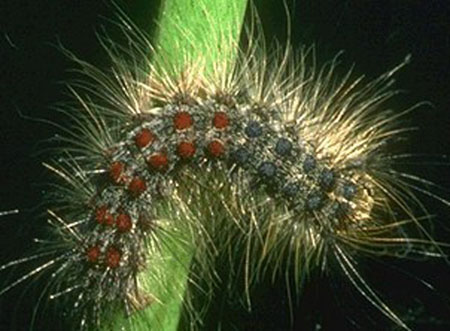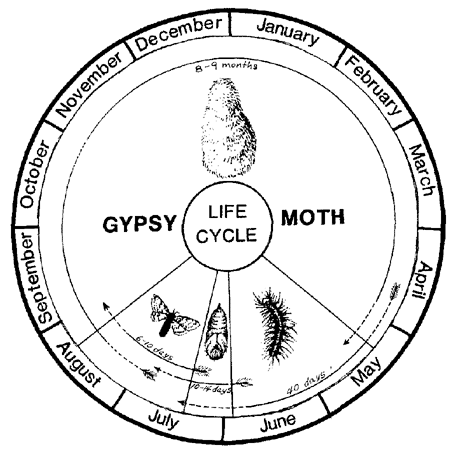Issue 7, June 4, 2010
On the Watch for Gypsy Moth
One of the most notorious hitchhiking insects, the gypsy moth, is also one of the most destructive forest pests in the United States. This defoliator is a voracious eater; and when populations are high, they can devour all of the leaves from the trees and plants in a neighborhood. It is during this time of year we start to turn our eyes to the tree tops looking for this leaf-eating creature.

Each larva can be from one to two inches long with hairs running down its entire body. The larvae are grayish in color with five pairs of blue spots and six pairs of red spots on their body with yellow markings on their heads. They transform into the pupal stage in mid-summer and emerge as adults, usually beginning in July. Male moths are light tan to dark brown with wavy bands and have a wingspan of about an inch. Females are almost all white with faint darker wavy bands on the forewings and have a wingspan up to two inches. Female gypsy moths do not fly and will typically lay their eggs near areas where they were feeding (including picnic tables, firewood, grills, and even cars). When these items are moved, these "hitchhikers" move with them! Larvae emerge from the mass the following spring (hatch generally occurs when most hardwood trees are starting to bud).

Oaks (Quercus spp.) are their preferred meal but they will feed on over 500 shrub and tree species. When large populations build up, 1000 egg masses per hectare, the damage can become quite extensive. This could lead to entire forests being stripped of their foliage. Healthy trees can usually withstand the loss of one flush of leaves. If this happens continuously throughout the year, in consecutive years, defoliation will mean almost certain failure, especially when coupled with other insect, disease, and environmental conditions.
The gypsy moth trapping program in Illinois is a cooperative effort between the Illinois Department of Agriculture and USDA-APHIS-PPQ. The goal of this survey is to determine the spread and dispersal of the gypsy moth in Illinois. Illinois is considered a transition state and is part of the Slow the Spread (STS) program. STS is one of the largest monitoring and action programs in the nation targeting the gypsy moth. Illinois Department of Agriculture is placing ~6,000 traps in the STS area (northeastern Illinois - where higher populations are more common). USDA-APHIS-PPQ heads the detection part of the trapping and is placing ~6,000 traps in 85 central and southern Illinois counties where this insect is not known to occur.--Kelly Estes
Author:
Kelly Estes